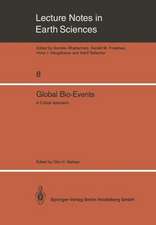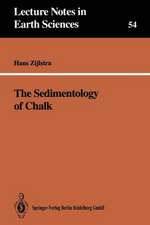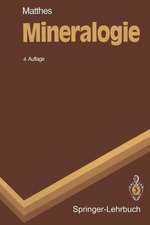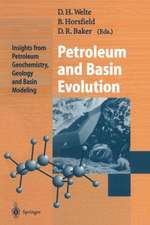The Utilization of Bioremediation to Reduce Soil Contamination: Problems and Solutions: NATO Science Series: IV:, cartea 19
Editat de Václav Sasek, John A. Glaser, P. Baveyeen Limba Engleză Hardback – 28 feb 2003
Advantages and limitations of each technology are discussed. The concept of natural attenuation is also critically evaluated since in some cases where time to remediation is not a significant factor, it may be an alternative to active bioremediation operations.
| Toate formatele și edițiile | Preț | Express |
|---|---|---|
| Paperback (1) | 1225.16 lei 6-8 săpt. | |
| SPRINGER NETHERLANDS – 28 feb 2003 | 1225.16 lei 6-8 săpt. | |
| Hardback (1) | 1229.91 lei 6-8 săpt. | |
| SPRINGER NETHERLANDS – 28 feb 2003 | 1229.91 lei 6-8 săpt. |
Din seria NATO Science Series: IV:
- 18%
 Preț: 1225.94 lei
Preț: 1225.94 lei - 15%
 Preț: 640.06 lei
Preț: 640.06 lei - 18%
 Preț: 953.65 lei
Preț: 953.65 lei - 18%
 Preț: 950.84 lei
Preț: 950.84 lei - 18%
 Preț: 950.96 lei
Preț: 950.96 lei - 18%
 Preț: 948.61 lei
Preț: 948.61 lei - 18%
 Preț: 945.92 lei
Preț: 945.92 lei - 15%
 Preț: 644.63 lei
Preț: 644.63 lei - 18%
 Preț: 945.92 lei
Preț: 945.92 lei -
 Preț: 402.56 lei
Preț: 402.56 lei - 15%
 Preț: 646.43 lei
Preț: 646.43 lei - 15%
 Preț: 647.08 lei
Preț: 647.08 lei -
 Preț: 394.51 lei
Preț: 394.51 lei - 18%
 Preț: 1230.21 lei
Preț: 1230.21 lei - 15%
 Preț: 657.57 lei
Preț: 657.57 lei - 18%
 Preț: 1835.83 lei
Preț: 1835.83 lei - 18%
 Preț: 1825.12 lei
Preț: 1825.12 lei - 18%
 Preț: 958.73 lei
Preț: 958.73 lei - 18%
 Preț: 951.29 lei
Preț: 951.29 lei - 18%
 Preț: 944.51 lei
Preț: 944.51 lei - 18%
 Preț: 1015.55 lei
Preț: 1015.55 lei - 15%
 Preț: 647.08 lei
Preț: 647.08 lei - 18%
 Preț: 1827.80 lei
Preț: 1827.80 lei - 18%
 Preț: 1835.53 lei
Preț: 1835.53 lei -
 Preț: 395.63 lei
Preț: 395.63 lei - 18%
 Preț: 944.99 lei
Preț: 944.99 lei
Preț: 1229.91 lei
Preț vechi: 1499.88 lei
-18% Nou
Puncte Express: 1845
Preț estimativ în valută:
235.35€ • 251.66$ • 196.22£
235.35€ • 251.66$ • 196.22£
Carte tipărită la comandă
Livrare economică 17 aprilie-01 mai
Preluare comenzi: 021 569.72.76
Specificații
ISBN-13: 9781402011412
ISBN-10: 1402011415
Pagini: 444
Ilustrații: XIX, 417 p.
Dimensiuni: 170 x 244 x 29 mm
Greutate: 0.79 kg
Ediția:2003
Editura: SPRINGER NETHERLANDS
Colecția Springer
Seria NATO Science Series: IV:
Locul publicării:Dordrecht, Netherlands
ISBN-10: 1402011415
Pagini: 444
Ilustrații: XIX, 417 p.
Dimensiuni: 170 x 244 x 29 mm
Greutate: 0.79 kg
Ediția:2003
Editura: SPRINGER NETHERLANDS
Colecția Springer
Seria NATO Science Series: IV:
Locul publicării:Dordrecht, Netherlands
Public țintă
ResearchCuprins
Rapid Detection/Identification of Microbes, Bacterial Spores, Microbial Communities, and Metabolic Activities in Environmental Matrices.- Comparison of Effective Organisms in Bioremediation Processes: Potential Use of Nucleic Acid Probes to Estimate Cyanide Degradation in Situ.- Modern Methods for Estimating Soil Microbial Biomass and Diversity: An Integrated Approach.- Recent Advances in the Biodegradation of Polycyclic Aromatic Hydrocarbons by Mycobacterium Species.- Toxic Metal Contamination Treatment with Microbes.- Aerobic Biodegradation of Polychlorinated Biphenyls (PCBs): The Fate, Distribution, Kinetics and Enhancement of PCB Biodegradation Efficacy in the Bacterial Cell Suspension of Pseudomonas stutzeri.- Adsorption of Heavy Metals to Microbial Biomass: Use of Biosorption for Removal of Metals from Solutions.- Nonenzymic Degradation and Decolorization of Recalcitrant Compounds.- The Impact of Sulfonation Pattern on Indigo Degradation by Phanerochaete chrysosporium Ligninolytic Enzymes.- Screening of Fungal Strains for Remediation of Water and Soil Contaminated with Synthetic Dyes.- Effect of Countermeasures of Radionuclide Uptake by Agricultural Plants.- Low-Cost Microbiotests for Toxicity Monitoring during Bioremediation of Contaminated Soils.- Application of Bioassays for Site-Specific Risk Assessment.- Effect of PAH-Contaminated Soil on some Plants and Microorganisms.- Development of immunomicroscopic methods for bioremediation.- Ecotoxicological Evaluation of PAH-Contaminated Soil Using Earthworms.- Use of Bioassays in Determining the Ecotoxicity of Industrial Soils.- Genotoxicity Estimation in Soils Contaminated with Polycyclic Aromatic Hydrocarbons after Biodegradation.- Ecotoxicological Hazard Assessment of Solid-Phase Samples.- Monitoring of Polychlorinated Biphenyls in Slovak Freshwater Sediments: Use of Semipermeable Membrane Devices.- Biopiles for Remediation of Petroleum-Contaminated Soils: A Polish Case Study.- Why mycoremediations have not yet come into practice.- From Laboratory to Industrial Scale: Composting of Polluted Soils from Former Coal Industry and Gas Plants: Future Research Needs.- Plant Biotechnology for the Removal of Organic Pollutants and Toxic Metals from Wastewaters and Contaminated Sites: Phytoremediation.- Consideration of Plant-Based Remediation and Restoration of Contaminated Sites Containing Heavy Metals: The Canadian Experience.- Combined Removal of Oil, Toxic Heavy Metals and Arsenic from Polluted Soil.- Landfarming Framework for Sustainable Soil Bioremediation.- Spent Mushroom Substrate: White-Rot Fungi in Aged Creosote- Contaminated Soil.- Bioremediation of PCBs from Contaminated Soil.- Problems of Soil Renovation on Former Military Sites in Lithuania.- The Capacity of Agricultural Soils to Auto-Regulate Bioremediation of Olive-Mill Wastewaters.- Accumulation of Organic Contamination in Plant roots and the Influence of Plant Rhizosphere on Removal of PAH, TPH and Heavy Oil Fractions from Soil.- Perspectives of Stable Isotope Approaches in Bioremediation Research.- Screening of Litter Decomposing Fungi for Degradation of Polycyclic Aromatic Hydrocarbons (PAH), Phenanthrene and benzo[a]pyrene.- Photosystem II-Based Biosensors for Phytoremediation.- Degradation of Polychlorinated Biphenyls (PCBs) in Contaminated Soil with Horseredish Peroxidase and Peroxidase from White Radish Raphatus sativus.- Successful Challenges during the Development and Application of Innovative Processes for the Bioremediation of Soils.- Current State of Bioremediation in the Czech Republic.














